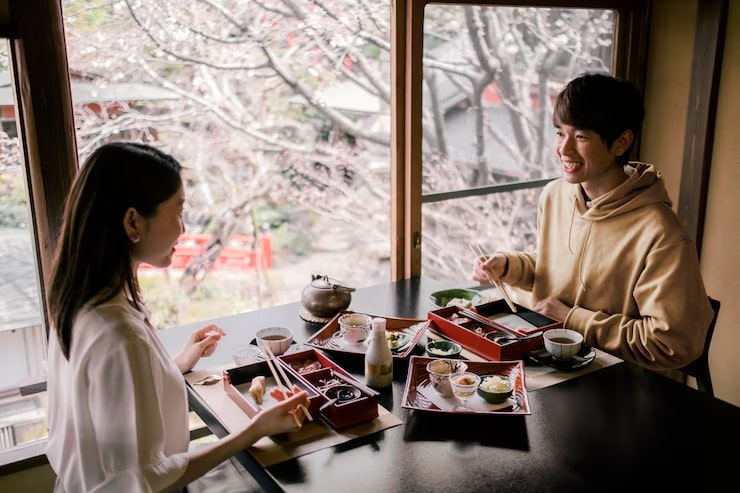
Japanese restaurants have a certain charm that many people love. The moment you walk in, you expect calm, warmth, and balance. A well-designed space doesn’t just make food look better. It makes the entire dining experience more enjoyable. That’s why design plays such an important role in Japanese restaurants.
You don’t need a big budget to create an inviting and stylish space. With the right ideas, even a small restaurant can feel authentic and elegant.
In this guide, we’ll explore simple yet stylish Japanese restaurant interior design ideas that can help you create a space your guests will remember.
Japanese Restaurant Elements
Whether you’re dining in Tokyo or at a sushi bar across the world, certain elements remain timeless.
- Minimalist Interior with Natural Materials: Wood, bamboo, stone, and paper textures dominate the design. You’ll often see sliding doors (shoji), tatami mats, or wooden accents, all creating a calm and grounded atmosphere.
- Open Sushi Bars or Counter Seating: Many Japanese restaurants highlight craftsmanship by letting you watch the chefs prepare sushi or grill yakitori right in front of you. It adds transparency, trust, and a personal connection to your meal.
- Traditional Tableware and Presentation: Expect elegant ceramic dishes, bento boxes, and neatly placed chopsticks. Each dish is arranged with balance and seasonal sensitivity in mind.
- Omotenashi (Japanese Hospitality): Service is quiet, polite, and deeply respectful. Whether you’re greeted with a warm “Irasshaimase!” or offered a warm towel (oshibori), the focus is on making you feel genuinely welcome and cared for.
1. Warm Wood Everywhere
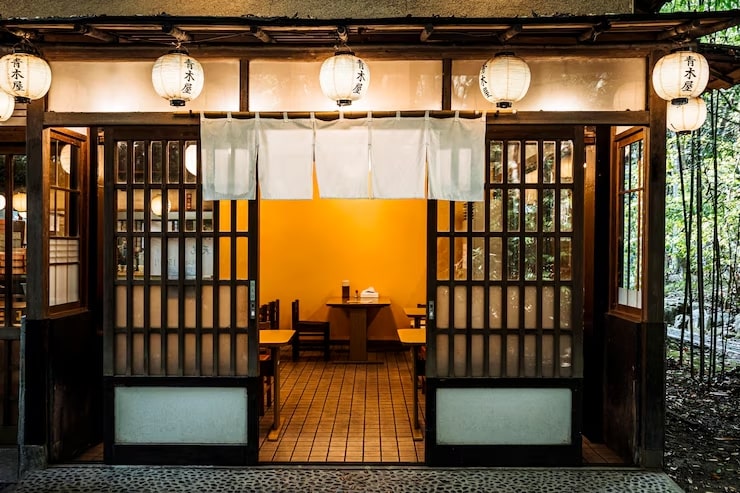
Natural wood is a must in any Japanese restaurant. Use it for walls, furniture, or ceiling beams. It brings warmth and calm into the space. Lighter shades make the room feel bigger.
2. Low-Set Seating Options
Traditional Japanese dining often uses floor seating. Offer a few low tables with tatami-style cushions. It creates an authentic, cosy feel that customers love.
3. Shoji Screen Dividers
Use shoji screens to divide areas without closing off the space. The light filters through beautifully. It’s simple, soft, and adds privacy without making it stuffy.
4. Minimalist Colour Palette
Stick to natural tones like beige, soft greys, and muted greens. These colours keep things peaceful and timeless. Accent with darker wood or black metal for contrast.
5. Zen Garden Corners
Add a small rock garden with pebbles, sand, and a bonsai tree. It’s a lovely visual break. Your diners will feel more relaxed the moment they see it.
6. Wooden Ceiling Slats

Install narrow, evenly spaced slats on the ceiling. It draws the eye up and adds texture. Works beautifully with recessed lighting, too.
7. Indoor Plants and Green Walls
Use bamboo, ferns, or moss panels. Greenery adds life without taking over. Choose plants that thrive in low light to keep maintenance easy.
8. Wasabi-Coloured Accents
Subtle green touches like wasabi cushions or napkins add flair. It’s a nod to the cuisine without being cliché. Plus, it complements natural materials well.
9. Furniture Customisation for Authenticity
Tailor your tables and chairs to match your theme. Consider curved wooden chairs or live-edge tables. Furniture customisation helps create a seamless visual flow.
10. Pendant Lantern Lights
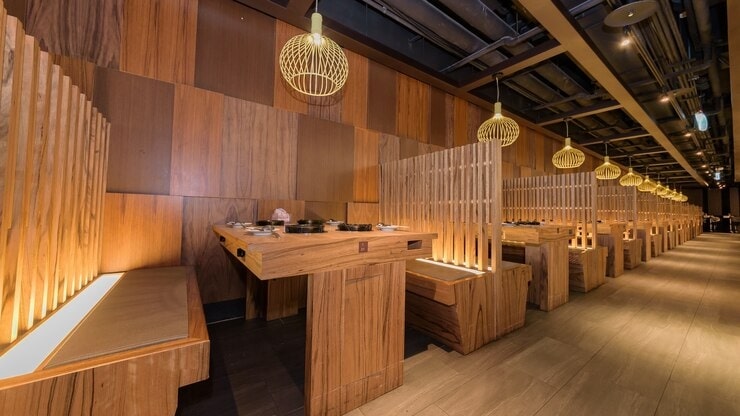
Soft, diffused lighting from paper or linen lanterns makes a space glow. Choose warm-coloured bulbs. They feel traditional but not old-fashioned.
11. Built-In Wooden Benches
Line one side of the room with a long bench. Add comfortable pads for seating. It saves space and looks super clean.
12. Subtle Stone Features
Use stone tiles for an accent wall or countertop. It adds weight and calmness to the room. Go for light grey or slate.
13. Traditional Artwork Displays
Hang Japanese prints or calligraphy art in simple wooden frames. You don’t need many. Just a few thoughtfully placed pieces will do the trick.
14. Natural Light Focus
Use large windows or glass panels to let sunlight in. Japanese design loves the outdoors. Even a small courtyard view can change the whole atmosphere.
15. Raised Platforms for Private Dining
Create a slightly raised platform with curtains or screens. It offers privacy while still feeling part of the space. Guests love the intimacy.
16. Black and Wood Contrast
Use black metal frames with wood surfaces. This combo feels modern and traditional at once. It also makes spaces feel sharper and cleaner.
17. Compact Table Layout
Use smaller tables that can be grouped or separated. Flexibility is key in tight restaurant interiors. It keeps the flow neat during busy hours.
18. Rice Paper Wall Art
Instead of paintings, use mounted rice paper with soft patterns or brushwork. It looks airy and elegant. And it’s a nice break from typical decor.
19. Hidden Lighting
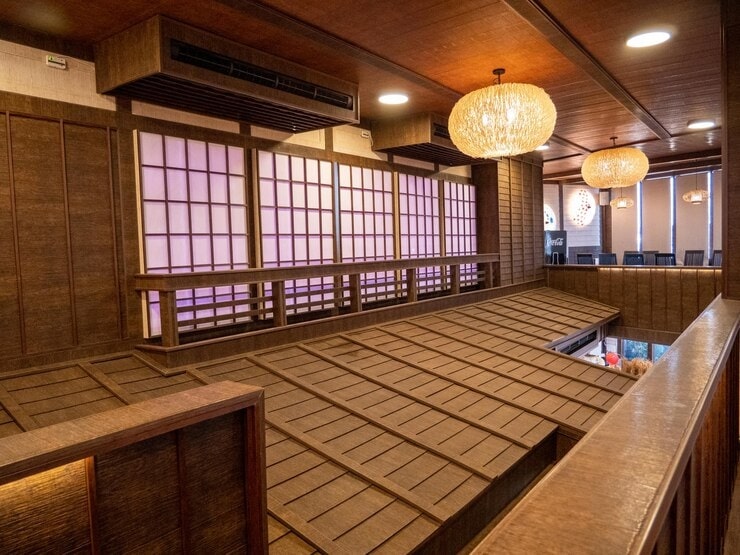
Tuck LED strips under shelving or behind wall panels. It creates a soft glow that feels high-end. Lighting is everything in restaurant interior design.
20. Handmade Ceramics on Display
Showcase bowls, teapots, or chopstick holders in open shelving. It’s decor with a story. Customers will appreciate the craftsmanship.
21. Remodelling Old Spaces into Calm Zones
If you’re updating an existing building, keep the structure but change the vibe. Remodelling lets you mix old bones with clean, modern design. Think reuse, not replace.
22. Accent Wall with Wood Panels
Choose one wall and clad it with vertical or diagonal wood planks. It’s warm, stylish, and not too loud. Looks great behind a sushi bar.
23. Private Booth Options
Install booth seating with soft lighting and neutral colours. It makes diners feel like they’re in their own little world. Great for date nights or business dinners.
24. Bamboo-Lined Countertops
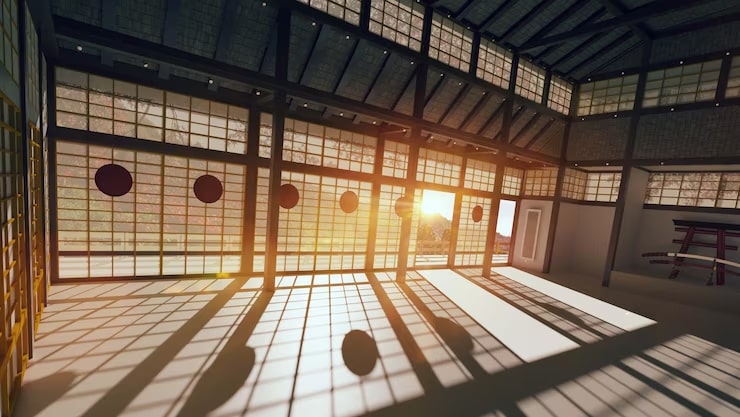
Use bamboo sheeting or strips on the sushi counter or bar. It gives a lovely texture. Just seal it properly to handle wear and tear.
25. Calligraphy Menus on the Wall
Write menu specials on wall-mounted scrolls or chalkboards. It’s practical and artistic. You can change them weekly to keep it fresh.
26. Geometric Wood Patterns
Use intricate latticework on doors or wall panels. These patterns look sharp and create visual movement. Best kept minimal so the room doesn’t feel busy.
27. Neutral Linen Curtains
Use light-coloured, flowy fabric for doorway curtains (noren style). It softens entrances and gives a bit of privacy without blocking airflow.
28. Hidden Tech Features
Tuck away speakers, aircon vents, or control panels behind wood screens. Keeps the aesthetic clean. Tech should be invisible in a stylish Japanese space.
29. Sake Display Shelves
Create a mini wall of sake bottles with soft lighting. It doubles as art and product placement. Change bottles regularly to add variety.
30. Japanese Pattern Tiles
Use subtle tiles with wave or fan motifs. Perfect for restrooms or behind a bar. These little touches make a big difference.
31. Bench Seating with Storage
Build benches with hidden drawers under them. It keeps the dining area tidy. Also handy for napkins, chopsticks, or cleaning supplies.
32. Entryway with Stone Path
Lay a short path of stone slabs leading to the main seating. It adds a peaceful moment as guests walk in. Simple but powerful.
33. Floating Wood Shelves
Mount thin, open wood shelves on blank walls. Place a few carefully chosen items — not too much. It keeps the walls alive but not crowded.
34. Simple Chopstick Holders on Tables
Custom wood or ceramic chopstick holders look premium. Pair with hand-folded napkins. Small table details matter a lot.
35. Textured Wall Panels
Use woven or rattan panels to add texture without colour. It keeps the space interesting without shouting. Ideal for side walls.
36. Use of Earthy Scents
Subtle use of sandalwood or hinoki oil diffusers can enhance the dining experience. It adds another layer to the atmosphere. Just don’t make it overpowering.
37. Uniform Table Heights
Keep all tables at the same level unless it’s a private zone. Uniform height helps visual balance. Makes serving easier, too.
38. Calm Background Music
Use instrumental koto music or lo-fi Japanese jazz. Soft, subtle, but unique. It sets the tone for a slow, mindful meal.
39. Framed Origami Decor
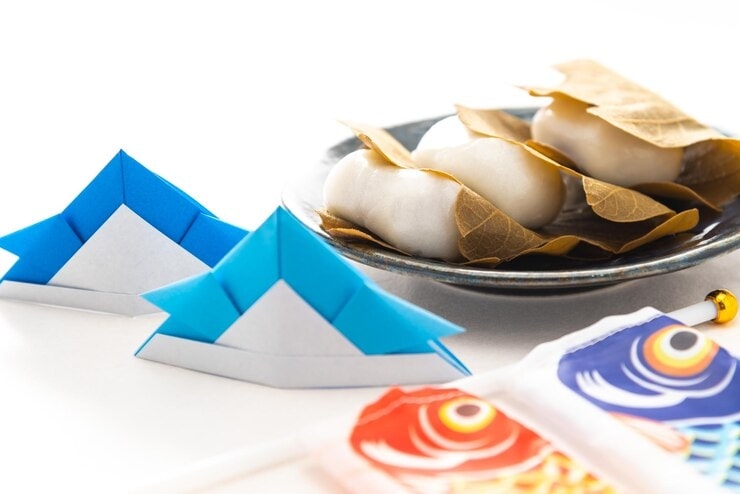
Hang framed origami in neutral tones. It’s cultural, creative, and lightweight. Works especially well in entry areas.
40. Mix of Open and Closed Storage
Open shelves show off your prettiest items. Closed ones hide the mess. Use wood and matte black finishes for consistency.
41. Modular Layouts for Flexibility
Design your furniture to move around. It helps you host private events or rearrange with ease. A great tip from interior consultation experts.
42. Understated Signage Outside
Keep your exterior sign minimal. Use wood or stone with small lettering. Let the food and experience do the talking.
43. Entry Curtain (Noren)
Hang a noren curtain at the front door. It flutters when someone walks in. Simple and deeply traditional.
44. Ceramic Tile Flooring
Choose earthy-tone ceramic tiles with grip. Easy to clean and feels grounded. Good mix of form and function.
45. Tatami Mat Wall Inset
Insert a section of tatami into the wall. It’s a soft-texture backdrop that screams Japanese design. Just don’t let it get wet.
46. Folding Partition Panels
For larger spaces, use folding screens to adjust the layout. You can go from open dining to semi-private events quickly. Stylish and practical.
47. Wood-Framed Lightboxes
Backlight panels with translucent rice paper. Great for menus or quiet corners. It glows gently and looks expensive.
48. Seasonal Flower Arrangements
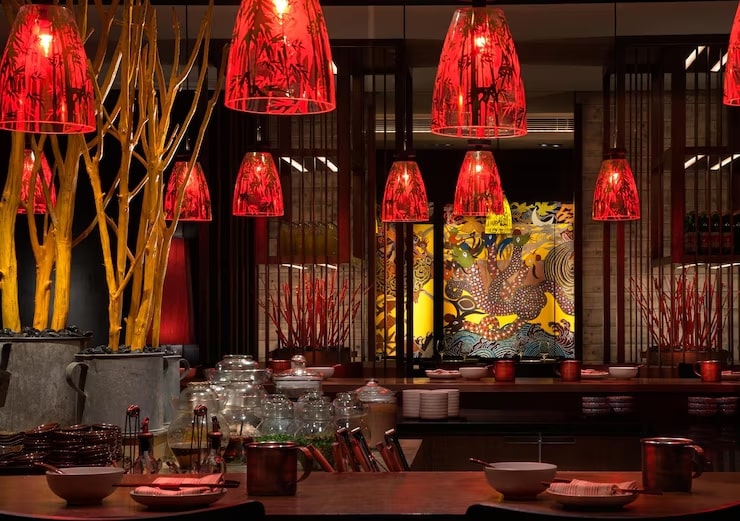
Add ikebana-style arrangements with seasonal blooms. It keeps the interior alive. Also shows attention to detail.
49. Tiled Service Counter
Tile the service counter with neutral patterns. Durable and design-forward. Avoid glossy finishes if possible.
50. Echo-Control with Wall Panels
Use soft panels or wood to reduce sound bounce. Japanese dining is often quiet. Keep that peaceful acoustic.
51. Rounded Corners on Tables
Tables with rounded edges look softer and more welcoming. It also feels safer in a small space. Subtle detail, big impact.
52. Modern Bistro Interior Styling Tips
Want a more fusion vibe? Add copper lighting, clean black lines, and textured plaster walls. These modern bistro interior styling tips balance elegance and simplicity.
53. Earth-Toned Uniforms for Staff
Dress your team in soft brown or grey uniforms. They blend into the calm design. It’s all about consistency.
54. Focus on Tabletop Details
Stone coasters, hand-stitched napkins, ceramic salt holders. These add refinement. Guests notice everything.
55. Arched Doorways
Soft arches make the space feel more open. Works well for bathroom or backroom entries. Looks better than square ones.
56. Adjustable Hanging Lights
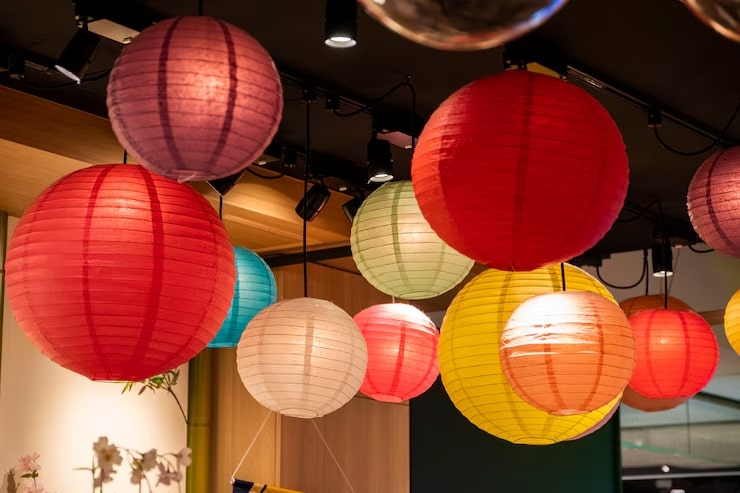
Hang pendant lights with adjustable cords. You can customise the atmosphere per table. Especially useful in narrow spaces.
57. Small Booth with Curtain Divider
Use a curtain instead of a wall to section off a booth. It’s flexible and warm. Adds a sense of privacy without closing it up.
58. Glassware Display with Lighting
Line up sake glasses or teacups on lit shelves. It adds sparkle. Just keep it dust-free.
59. Consistent Flooring Throughout
Use the same flooring type across the space. It keeps everything feeling connected. Wood, tile, or polished concrete all work well.
60. Slimline Furniture
Choose tables and chairs with narrow legs and light profiles. Helps with visual flow and tight spacing. Minimal but strong.
61. Balanced Symmetry in Layout
Balance your furniture and decor from left to right. Symmetry feels calm and intentional. That’s the secret behind great restaurant interior design.
Conclusion on Japanese Restaurant Design Ideas
Designing a Japanese restaurant doesn’t have to be complicated. By focusing on simplicity, natural elements, and thoughtful touches, you can create a space that feels warm, stylish, and inviting.
For design guidance that brings your vision to life, connect with Yang Design Associates Pte Ltd.
Contact us to explore our services and start your project today!
Frequently Asked Questions About Japanese Restaurant Design Ideas
What Are the Key Elements of Japanese Restaurant Design?
Clean lines, natural materials, soft lighting, and a calm layout are key. These elements create a peaceful and authentic dining space.
How Can I Make a Small Japanese Restaurant Look Stylish?
Use mirrors, compact furniture, and vertical space. Stick to a simple colour scheme and avoid clutter.
Which Colours Work Best in Japanese Interiors?
Soft neutrals like beige, white, and grey are popular. You can add deep greens or reds as accents.
What Type of Lighting Should I Use?
Warm, low lighting works best. Try paper lanterns or wooden pendant lights for a soft and cosy glow.
Is It Important to Add Traditional Japanese Decor?
Yes, but keep it minimal. One or two authentic touches, like noren curtains or calligraphy art, can enhance the space without overdoing it.

